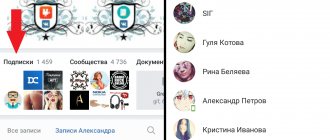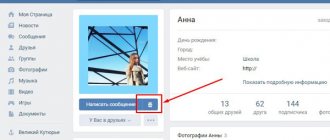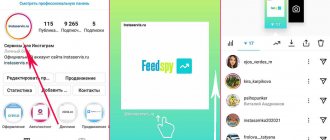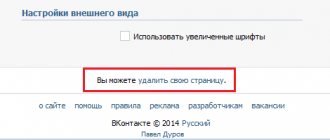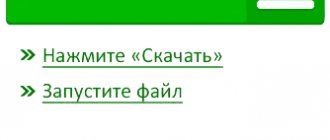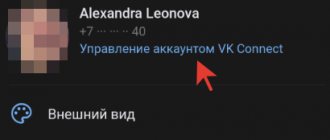Today we decided to tell you how to recognize a fake page on VK, because, as statistics show, there are so many fakes on this social network. Why are fake profiles created? Yes, there are any number of reasons!
- From hooliganism to write nasty things to friends;
- Out of curiosity to find out what the other half is doing;
- For the purpose of using for cheating or sending spam;
- To carry out illegal activities;
- Etc.
As you understand, meeting a fake on VK is unlikely to lead to anything good. At best, you will simply communicate with a fake person. At worst, you'll get yourself into trouble. That is why, we believe, every user should learn how to recognize a fake VKontakte page.
Standard methods for checking photos for fakes
Visually identifying a fake is almost impossible if the post-processing of the original image is done professionally. For this purpose, you need to use special programs and network resources.
You can obtain information and verify its authenticity using standard functions built into Internet browsers.
"Yandex"
This browser is focused on searching for content primarily in the Russian-speaking sector. Therefore, to check photographs posted on Russian Internet resources, using Yandex gives more accurate results.
Yandex search gives excellent results.
To get information about the image you are interested in, right-click on it. In the window that opens, you need to activate the “Find this image in Yandex” function. The following information appears:
- photo size;
- address of the resource on which it is posted;
- availability of the same picture in other resolutions;
- similar images.
By comparing the photos found by the browser with the image you are checking, you can detect the changes made.
You can check a photo saved on a computer or external storage device in the same way as a photo from the Internet. To do this, you need to drag the image file into the Yandex address bar, and the photo will appear in the browser.
Checking a graphic file for fakes in this browser is carried out in the same way as in Yandex. Only in this case, by right-clicking on the photo, you need to select the line “Find image (Google)”.
Checking in Google is carried out in the same way as in Yandex.
In all browsers, you can verify the authenticity of a photo by dragging it into the image search field. To do this, you must first activate this function by left-clicking on the camera icon.
The search engine will show all pictures similar to the uploaded photo. Among them you can find the source code that served as the basis for photomontage.
Spring 2021: why, along with the coronavirus, did an epidemic of fakes take over the world?
The world will probably never forget the spring of 2021: this was the first time in the history of mankind when humanity paused itself and almost the entire planet went into quarantine due to the coronavirus pandemic.
We sat in our apartments, every day we went to social networks and telegram channels, followed the news in the chat of a school class, a residential building, a work project...
And along with the coronavirus, the world has been overwhelmed by an epidemic of fakes.
Try to count how many waves of excitement have passed through you? Frantic buying of toilet paper and buckwheat, masks, ginger, baking soda, lemons... From time to time local horrors flared up here and there: “A coronavirus patient was found in our house!”, “There is an easy way to check whether you are sick or not: you need to inhale and not to breathe, and then...", "It turns out that in fact..."
Where do they come from? After all, in this case, no one tried to profit from the panic (I have little faith in the cartel agreement of the soda, lemon and ginger manufacturers). Who generates them?
The correct answer is that we generate.
One day I was able to almost completely unwind the fake chain. In the microdistrict where I live, there was a major utility accident: a sewer pipe burst. Accordingly, to prevent residents from being flooded with waste products, the water was turned off: both cold and hot.
It is clear that the sewer system continued to operate, but at least the pressure in the collector was not so great (and this made it possible to repair it).
And it is clear that the drought in taps created a lot of problems for residents.
Almost immediately, a screenshot of a message from a certain Anya rushed through the parent chats of kindergartens and schools (alas, today they are becoming the most fake-friendly environment). “My relative works in the district administration - he said: for a week! This will take at least a week!”
Advertising
Fortunately, the district administration is not so far away that it is impossible to call them.
- Girls, why are you panicking? — I insinuatingly asked my friends.
“We have no idea,” the girls answered. - Most likely, someone rashly said: “Okay, now it’s a week to clear things out!” - and they picked it up.
It is clear that the collector is being repaired in an emergency manner. And it is clear that after the residents of the microdistrict are given water again, the repair work does not end - they simply move into a calmer phase.
Apparently, that same “relative from the administration” meant that he himself would have to work as a collector for the entire coming week—maybe without even leaving his office: sending reports and schedules. Or maybe he meant that after completing the repair work on this collector, he would have to check other “bottlenecks”.
Or maybe... he didn't exist at all. And the unknown Anya only heard a snippet of conversation in transport. But she couldn’t help but share with her friends the information that seemed important to her. And my friends couldn’t help but share it with their friends.
Do you feel how fakes are emerging? Yes, just like rumors. Someone heard something unusual, amplified it a little to give the information weight - and retold it so that his words did not go unnoticed.
Why did he do this? Because he is a man. This means he needs attention. Sometimes this need is conscious, sometimes it is not, but it exists in almost everyone who writes posts on social networks, reposts interesting information and shares funny memes with friends. If it didn’t exist, we would maintain social networks in the “my dear diary” format and set the status of publications to “only I see.”
There are no fundamental differences between the creator of a fake and the one who republishes it: both the first and the second behave like a five-year-old boy who found a dead toad on the ground and runs with it to the children:
- Look! Look what I have!
Both the first and the second want to feel a sense of self-worth.
Advertising
Authenticity testing using extensions
Browser extensions are used to verify the authenticity of photographs. They enable a more complete analysis of the image compared to the built-in standard functions.
Such utilities have the words reverse image in their name. In Chrome you need to do this:
- Open the “Settings” section (3 dots in the upper right corner of the page).
- Find the line “Additional documents”.
- Select "Extensions".
- Open an online store.
- Download and install the appropriate plugin in your browser.
You can check for authenticity using extensions.
In Yandex you need to do the following:
- Left-click on the settings menu (3 horizontal lines in the top line of the window).
- Activate the "Add-ons" line.
- Scroll down the page to the “Extension Catalog” button.
- In the “Search” window, enter reverse image.
- Download and install any of the found plugins in Yandex.
Such applications find exact matches of the image being checked on the Internet and determine what adjustments were made to the original photo.
Using special online services to check the originality of a photo
You can check the authenticity of an image using online services that allow you to analyze the changes made as a result of processing the original photo. These services are rich in functionality and do not load your computer's processor.
FotoForensics
This service analyzes the uploaded photo and tracks all changes present in it, comparing it with the original. Detected edits are marked with spots that contrast with the main background in color and brightness. The analysis process reveals not only overlapping objects, but also adjustments to sharpness, saturation, and contrast settings.
FotoForensics allows you to determine the authenticity of photos.
FotoForensics is not available for the Russian segment of the network. The owners of the site prohibited its loading in the Russian Federation. In their opinion, 80% of violations of non-commercial use rules come from there. They promise to review the blocking in January 2022.
TinEye
By uploading the URL of an image to this site, the user receives a list of all Internet resources on which identical images are found, regardless of their size. The service is provided free of charge. All you need to do is upload the link of the photo you are checking to the website and wait for the analysis results.
Findexif
You can upload a photo to the service of this site for free to obtain the following information:
- parameters – size, exposure, focal length, aperture;
- model of camera or phone from which the photo was taken;
- date and time of shooting.
In some cases, the location where the photograph was taken may be indicated.
Findexif is a service where you can upload photos.
If the picture was processed in a graphics editor, this information will be reflected in the report.
Image Edited
You can find out whether a photo has been edited by dragging its file onto the page of this resource. In the free version, the site only gives a positive or negative answer. For an additional fee, you can obtain detailed information about the original image data.
Checking a photo for fake using the social network VKontakte
Not all photos posted on a personal account page are true and belong to their owners. There are ways to verify the authenticity of such images:
- Search for similar photos using browsers. If it turns out that such a picture belongs to a popular artist or athlete, and the owner of the account introduces himself as an astronaut, most likely the photograph is a fake.
- A person leaning on a luxury car may turn out to be the owner of an old Lada. If you look closely at the photo, you will notice that the car and its owner are casting shadows in different directions. This is an obvious photomontage.
- The high quality of the photo may raise suspicions that the interlocutor is impersonating another person. Perhaps the card for the avatar was borrowed from one of the photo stocks.
- You can also detect traces of image enhancement using the online services described above.
The VKontakte photo can be verified for authenticity.
Why are fakes created?
There are several goals pursued by fake content creators. The most common ones should be considered:
- intentional misinformation of users about any facts or events for the so-called hype - attracting attention in order to make money;
- formation of a certain view of things in the consumer of information;
- carrying out fraudulent and fraudulent transactions;
- open insult to certain persons;
- agitation;
- trolling (most often in such cases, a fake is created for entertainment and self-affirmation by participating in disputes and discussions);
- advertising a specific product or bypassing spam limits (after all, most social networks have restrictions on adding friends and sending letters);
- the desire to maintain anonymity and confidentiality, not to “share” personal information;
- personal motives (for example, the desire of a notorious user to have a double who has a different image).
Program "Etxt Anti-plagiarism"
This program can be downloaded for free on the Etxt copywriting exchange website. It was originally intended to assess the uniqueness of texts. It has now become possible to check photos for matches with other sources on the network. This utility can be installed on your computer.
To start analyzing an image, you need to enter the path to its file stored on your hard drive or the URL of the image from the Internet.
After searching online for photos similar to the original one, both are shown side by side in the program window.
Ways to make an image more unique
Search engines find similar photos by comparing their raster structure. You can deceive the robotic analysis algorithm if you make changes to the pixel array of the borrowed image. This is easy to do using photo editors, for example, add a logo, replace the background, etc. However, not all methods of correcting a source file transform it beyond recognition for a search engine.
After each operation, you need to check and proceed to the next transformation. When assessing the degree of identity of pictures, different services often disagree. The table contains the results of checking the uniqueness of the image in the Yandex and Google Chrome browsers, as well as the Etxt Anti-Plagiarism program:
| Uniqueness of the processed image according to the service version: | |||
Source photo correction method | "Yandex" | "Google Chrome" | "Etxt Anti-plagiarism" |
| Result achieved, yes/no | |||
| Trimming | No | No | No |
| Changing the background | Yes | Yes | Yes |
| Logo overlay | No | No | Yes |
| Renaming a file | No | No | No |
| Replacing the extension | No | No | No |
| Turn | Yes | Yes | Yes |
| Mirror reflection | No | No | No |
| Free Transformation | Yes | Yes | Yes |
| Adding Perspective | Yes | Yes | Yes |
To partially hide traces of editing, you can save the file to your hard drive multiple times in succession. This procedure leads to the gradual erasure of information from the original photograph.
What other way is there to distinguish fake from non-fake?
First of all, turn off your emotions (this is difficult - that’s why I suggest testing the post with Google or Yandex first) and turn on your cool mind. And then, with a cold mind, answer the following questions:
1. How actively does the publication encourage you to transfer money “right now”? The more often phrases like “we only have an hour” are used, the higher the likelihood that you have stumbled upon a scam. In fact, such phrases fuel your emotionality, building a direct connection between your money and human life.
But transferring money is not a blood transfusion. And there are no situations in which you need money now, but an hour later it’s too late. This time lag is always longer.
2. How chaotic is the publication? Of course, a person in a state of shock may not express his thoughts in the most logical way, but there is an extremely important point here. A person in a state of shock presents an illogical, completely logical reality - he simply forgets some details. The fraudster shapes this reality.
Moreover, not being a great specialist in medicine, he presents this reality rather absurdly. What is the value, for example, of the phrase: “Within an hour, you need to find another 298 thousand rubles for a plate in the skull that can give you a chance. My daughter will last another two hours on the machine; she is ready for surgery. Doctors will do everything for free, money is needed for the plate.”
What kind of device can my daughter survive on? What is this miraculous plate, without which a person can live for only two hours? And why does it need to be installed for money, if any emergency operations are always performed free of charge? Yes, then, during rehabilitation, money (and perhaps a lot of it) may indeed be required, but there will not be a situation like “money is needed urgently, within two hours.”
3. When was the publication made? It is very possible that you saw her 15 hours after her appearance (you don’t spend time on social networks all the time). Well, if you read a cry for help reposted by someone, first of all write privately to the author of the repost: “Do you really know this person? Can you guarantee that this is not a fake?”

